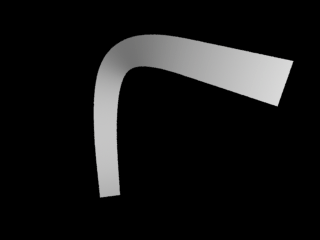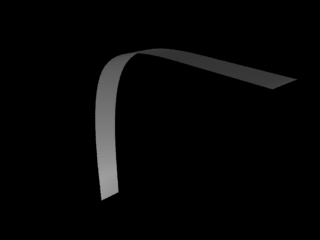| |
Introduction
As of RenderMan Artist Tools version 11.5.3 the only attribute that can be assigned
to a Maya curve using mtor is "constantwidth". Pixar's mtor plugin allows a curve
to have a uniform width but not a sequence of width's or colors etc.
However, there are work-arounds. Both techniques involve post-processing the RIB files
generated by Maya/mtor in such a way that the Curves statements are modified to include
the "extra" attributes that we wish to assign a curve.
The difference between the work-arounds is that the simple one inserts extra curve data,
say, widths or colors into a RIB file before it is rendered - see
post processing curve widths. The
disadvantage of this technique is that the data added to the curves in a RIB file
cannot be directly controlled from "within" Maya.
This tutorial describes a more advanced (tricky would be a better) technique that
relies on taking information from the Maya scene and "encoding" it into the names of the
curves. In the example shown in this tutorial we will take information about the curve
normals at points along each curve where V is 0.0, 0.33, 0.66 and 0.999. The
RIB file(s) produced by Maya/mtor are post processed in such a way that the data
previously "hidden" in the names of curves is de-coded and added to the curve.
Before and After
Before we implement this data-hiding technique lets look at a part of a RIB file
before and after it has been post processed. The snippet of RIB shown below assumes
we have run the MEL scripts shown in listings 1 and 2. The strange looking name, shown
in bold, is the result of listing 1 encoding the data from normals at 4 locations
sampled along the length of the curve.
|
A Curves RIB statement from Maya/mtor
|
AttributeBegin
Attribute "identifier" "name" ["|curve1_p999_p001_n001..."]
ConcatTransform [1 0 0 0 0 1 0 0 0 0 1 0 0 0 0 1]
ShadingInterpolation "smooth"
Basis "b-spline" 1 "b-spline" 1
Curves "cubic" [8] "nonperiodic" "P" [0 0 0 0 0 0 0 0 0 0 2 0
1.5 2 0 2 2 0 2 2 0 2 2 0] "constantwidth" [0.5]
AttributeEnd
|
The normals are encoded to 3 decimal places. This seems to provide sufficient
accuracy for most purposes while preventing the curve names from becoming
too long.
|
Curves statement after post processing
|
AttributeBegin
ConcatTransform [1 0 0 0 0 1 0 0 0 0 1 0 0 0 0 1]
ShadingInterpolation "smooth"
Basis "b-spline" 1 "b-spline" 1
Curves "cubic" [8] "nonperiodic" "P" [0 0 0 0 0 0 0 0 0 0 2 0
1.5 2 0 2 2 0 2 2 0 2 2 0] "constantwidth" [0.5]
"N" [0.999 0.001 0.001 ...more xyz's]
AttributeEnd
|
|
|
|
listing 1 - addNormalsToCurve.mel
|
//_________________________________________________
// encode
//_________________________________________________
// Turn a float into a "coded" string. Note: only 3
// decimal places of accuracy.
proc string encode(float $f)
{
string $out;
if($f >= 0 && $f < 0.001)
$out = "p001";
else if($f < 0 && $f > -0.001)
$out = "n001";
else if($f > 0.999)
$out = "p999";
else if($f < -0.999)
$out = "n999";
else if($f < 0)
$out = "n" + abs(trunc($f * 1000));
else
$out = "p" + trunc($f * 1000);
return $out;
}
//_________________________________________________
// addNormalsToCurveName
//_________________________________________________
// $name must refer to a curve with 4 CV's.
proc string addNormalsToCurveName(string $name)
{
string $newname = $name;
vector $norm[4];
for($i = 0; $i < 4; $i++)
{
$norm[$i] = `pointOnCurve -nn -pr ($i * 0.333) $name`;
vector $v = $norm[$i];
$newname += "_" + encode($v.x);
}
rename -ignoreShape $name $newname;
return $newname;
}
|
|
|
|
listing 2 - makeCurves.mel
|
//_________________________________________________
// length
//_________________________________________________
// returns the length of a 2d vector
proc float length(float $a, float $b)
{
return sqrt($a * $a + $b * $b);
}
//_________________________________________________
// makeCurve
//_________________________________________________
// Makes a single curve that "droops" down in Y by
// an amount thats proportional to the length of the
// curve in the X-Z plane.
proc string makeCurve(vector $v)
{
$v = $v + unit(sphrand(1) * 0.25);
vector $d = $v/3;
vector $cv0 = <<rand(-0.25,0.25), 0, rand(-0.25,0.25)>>,
$cv1 = $d * 1;
$cv2 = $d * 2;
$cv3 = $d * 3;
float $len = length($v.x, $v.z),
$droop3 = $len * rand(2, 0.950),
$droop2 = $len * 0.25,
$droop1 = $len * 0.15,
$cv1 = <<$cv1.x, $cv1.y - $droop1, $cv1.z>>;
$cv2 = <<$cv2.x, $cv2.y - $droop2, $cv2.z>>;
$cv3 = <<$cv3.x, $cv3.y - $droop3, $cv3.z>>;
string $name = `curve -d 3 -p ($cv0.x) ($cv0.y) ($cv0.z)
-p ($cv1.x) ($cv1.y) ($cv1.z)
-p ($cv2.x) ($cv2.y) ($cv2.z)
-p ($cv3.x) ($cv3.y) ($cv3.z)`;
string $shape[] = `listRelatives -s`;
addAttr -ln mtorCurveWidth -dv 0.01 -k true $shape[0];
return addNormalsToCurveName($name);
}
//_________________________________________________
// makeCurves
//_________________________________________________
// Makes a bunch of curves each of which "point" in
// the general direction of vector $v, with their bases
// located around the (position) vector $p.
proc makeCurves(int $num, vector $v, vector $p)
{
string $items[];
for($n = 0; $n < $num; $n++)
$items[$n] = makeCurve($v);
xform -t ($p.x) ($p.y) ($p.z) $items;
}
|
|



